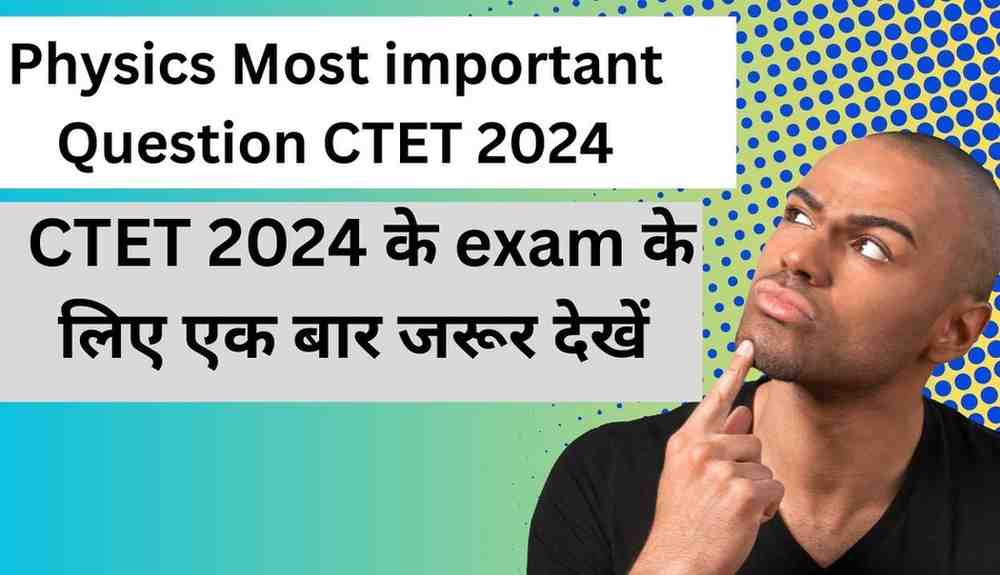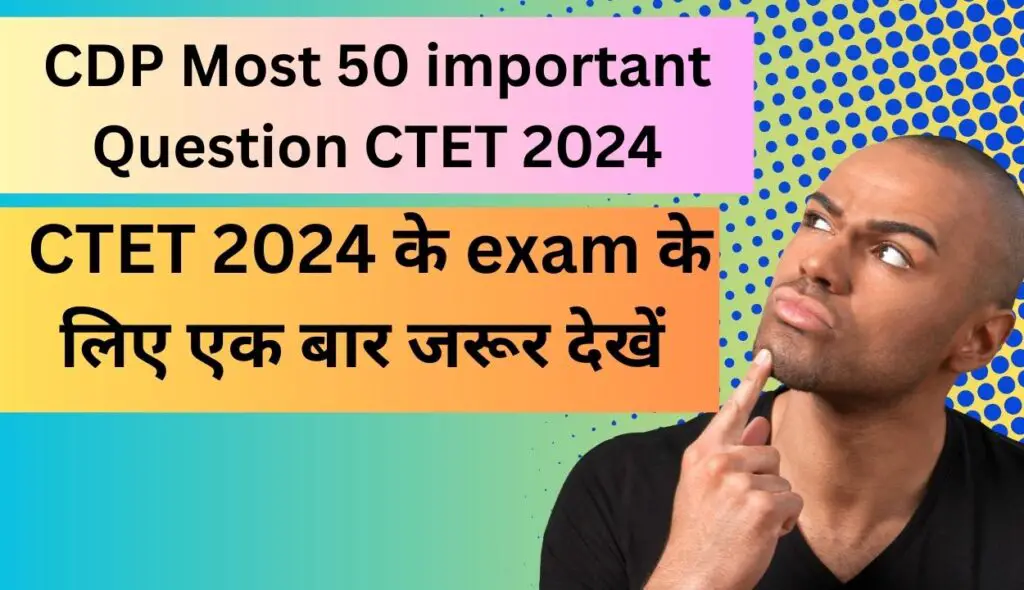CTET 2021 CDP Question Paper 28 December 2021: / CTET 2021 CDP Question Paper 2 केंद्रीय शिक्षक पात्रता परीक्षा (CTET) दिसम्बर 2021 से जनवरी 2022 को आयोजित हुई है। इस परीक्षा में पेपर वन में पांच खंडों होते हैं। जिसमें अंग्रेजी भाषा, हिंदी भाषा, गणित और पर्यावरण अध्ययन – CDP से पूछे जाएंगेI CTET CDP सिलेबस 2021 के अनुसार, इस खंड में बहुविकल्पीय वस्तुनिष्ठ प्रारूप में कुल 30 प्रश्न पूछे जाते हैं। प्रत्येक प्रश्न 1 अंक का है और कोई नकारात्मक अंकन नहीं होता है। ये जो question पेपर 2 CDP का है
DATE OF EXAM – 2021-12-28
CTET 2021 CDP Question Paper 28 December 2021
1. Which of the following principles defines that – development is a life-long process that never ends?
Options :
1. Principle of uniformity 2. Principle of integration
3. Principle of interaction 4. Principle of continuity
2. Which of the following statements about the children is correct from a socio-constructivist perspective?
Options :
1. Children’s behaviour can be explained in terms of small, incremental change due to experience;
2. Children’s behaviour is totally determined by early experiences in life.
3. Children are born ‘noble savages’ and are corrupted by the society.
4. Children are active beings who construct knowledge by acting upon and interacting with their socio-cultural context
3. While playing, a group of children enact scenes from a recent popular movie. This situation highlights that__________________is an important agency of socialization.
Options :
1. family 2. media 3. peers 4. Religion
4. Match ‘stages of development’ with ‘its characteristics’ as given by Jean Piaget:
1. Formal operation stage——————(A) Able to think logically and can conserve
2. Pre-operation stage——————(B) Starts to reasoning hypothetically and abstractly
3. Concrete operational stage —————— (C) Begins to understand permanence of objects
4. Sensorimotor stage——————(D) Starts thinking symbolically but cannot conserve
Options :
1. 1-A, 2-D, 3-B, 4-C
2. 1-B, 2-D, 3-A, 4-C
3. 1-D, 2-A, 3-B, 4-C
4. 1-B, 2-A, 3-C, 4-D
5. According to Jean Piaget, which of the following is necessary for learning?
Options :
1. Reinforcement and punishment
2. Active exploration by the learner
3. Observation and imitation
4. Language development which facilitates social interaction
6. Which of the following is not advocated in a socio-constructivist classroom based on Lev Vygotskian constructs?
Options :
1. Learning-for-exam 2. Creativity and critical thinking
3. Conceptual understanding 4. Experimental learning
7. According to Lev Vygotsky, how do children acquire the ways of thinking and behaving that makes up a community’s culture?
Options :
1. Through social interaction 2. Through passive reception
3. Through conditioning 4. Through reinforcement.
8. Which of the following describes ‘Universal ethical principle orientation’ stage of moral development proposed by Lawhrence Kohlberg?
Options :
1. Satisfying personal needs
2. Maintaining the affection and approval of friends and relatives
3. Abstract universal principles that are valid for all humanity.
4. A duty to uphold laws and rules for their own sake.
CTET 2021 CDP Question Paper 30 December 2021
9. Progressive education views children as
Options :
1. born with a high sense of morality and ethics which are ‘god-gifted’
2. Tabula rasa’ or blank slates.
3. miniature adults whose thinking is lesser than adults.
4. curious beings who learn through exploration of their surroundings.
10. Which of the following options correctly specifies the types of intelligence given by Howard Gardner?
Options :
1. Therapist, Biologist, Industrialist 2. Athletic, Creative, Expressive
3. Practical, Analytical, Creative 4. Intrapersonal, Naturalist, Bodily-kinaesthetic
11. In Vygotskian framework, language
Options :
1. hinders cognitive development 2. facilitates cognitive development
3. does not influence cognitive development 4. functions independently of cognitive development
12. In a co-educational classroom which behaviour of the teacher would reinforce gender stereotyping and hence should be avoided?
Options :
1. Same sex grouping and allotting differentiated learning tasks to boys and girls.
2. Showing males and females in non-conformist roles.
3. Discussing gender as a social construct.
4. se of gender neutral language
13. Which of the following tools/methods does National Education Policy 2020 propose for assessment of children?
(i) Role plays (ii) Group work (iii) Portfolios (iv) Projects
Options :
1. (ii), (iii) 2. (i), (iii), (iv) 3. (ii), (iii), (iv) 4. (i), (ii), (iii), (iv)
14. Which of the following statements about the use of mother tongue by learners in the classrooms is correct?
Options :
1. Schools should prescribe only one standard language for use in the classroom across all classes.
2. Schools should build a culture of respecting languages of all learners.
3. Schools should prescribe ‘English’ as the medium of instruction at all levels.
4. Schools should discourage learners from expressing in their mother tongue by imposing fines.
15. Assertion (A): A teacher should adopt a culturally-responsive pedagogy in her class giving primacy to children’s socio-cultural contexts.
Reason (R): Schools need to follow structured uniform curriculum and individual differences should not be considered in the classroom. Choose the correct option.
Options :
1. Both (A) and (R) are true and (R) is the correct explanation of (A).
2. Both (A) and (R) are true but (R) is not the correct explanation of (A).
3. (A) is true but (R) is false. 4. Both (A) and (R ) are false.
16. What are the identifying characteristics of dyscalculia?
Options :
1. Impaired maths calculation skills and difficulty in understanding numbers and maths facts.
2. Inattention, hyperactivity, and impulsivity.
3. Originality, fluency, flexibility.
4. Difficulty in muscle control, movement and coordination.
17. Inclusive education includes –
(i) Students with learning disability. (ii) Gifted students.
(iii) Students with visual impairment. (iv) Students from marginalized communities.
Options :
1. (i), (iii) 2. (i), (iii), (iv) 3. (i), (ii), (iii) 4. (i), (ii), (iii), (iv)
18. What behaviour of a child will indicate to a teacher that the child has visual impairment?
Options :
1. Choosing to read the blackboard from far away.
2. Reading physical maps with minute details.
3. Completing worksheets with fine print quickly.
4. Struggling to read and squinting eyes while doing so.
19. To cater to the needs of learners who are gifted, a teacher should
Options :
1. give specific instructions and detailed guidelines for undertaking tasks.
2. strictly follow the prescribed curriculum.
3. use standardized assessment measures.
4. give moderate to higher order thinking tasks.
20. Which of the following should be practiced in an inclusive classroom?
Options :
1. Diagnostic labelling 2. Reasonable accommodation
3. Segregation of children 4. Competitive classroom ethos
21. Which of the following factors affect learning?
(i) Attitude of the learners (ii) Age of the learners
(iii) Pedagogical strategies of teaching (iv) Socio-cultural content of the learners
Options :
1. (i), (iii) 2. (ii), (iii), (iv) 3. (i), (ii), (iii) 4. (i), (ii), (iii), (iv)
22. To learn meaningfully-
(i) children need to feel valued. (ii) children’s experiences should be taken into account.
(iii) children should not be allowed questioning.
Options :
1. (i), (ii) 2. (i), (iii) 3. (ii), (iii) 4. (i), (ii), (iii)
23. How should a middle school teacher respond to the errors made by the students during the process of learning?
Options :
1. Immediately correct the students errors
2. Ask a peer to correct the student’s errors
3. Give students opportunities to identify their own errors and work upon them
4. Shame the students so that they don’t make any errors in future
24. A student who considers herself ‘good at maths’ blames her poor marks in exams on her failure to have studies hard. This reasoning reveals
Options :
1. an internal locus of control 2. her learned helplessness
3. uncontrollable factors 4. her belief in her ability
25. Is there a role of fear in teaching-learning process? Choose the best option.
Options :
1. Yes, fear is a great motivator and should be used frequently by the teacher.
2. No, fear leads to withdrawal from learning and students take very few risks in fearful situations.
3. Yes, it is under the pressure of fear only that children make efforts to learn.
4. No, fear is an emotion and thus is not connected with cognition.
26. Assertion (A): Teachers should focus upon and encourage children to develop metacognitionability to think on one’s own thinking.
Reason (R): Metacognitive knowledge is helpful for children to self-regulate their thinking. Choose the correct option.
Options :
1. Both (A) and (R) are true and (R) is the correct explanation of (A).
2. Both (A) and (R) are true but (R) is not the correct explanation of (A).
3. (A) is true but (R) is false. 4. Both (A) and (R ) are false.
27. Out of the following, which mode of learning would best promote meaningful learning?
Options :
1. Rote memorisation 2. Passive listening
3. Understanding through linkages 4. Drill and repeated practice
28. Students construct a lot of intuitive theories about natural phenomenon. A teacher should
Options :
1. discourage the students from doing so.
2. punish the students from constructing their own conceptions that do not confine to the textbook.
3. encourage the students to share these pre-conceptions and build the teaching- learning pedagogy around them.
4. Ignore these theories and teach the concepts through direct instruction.
29. While teaching for conceptual understanding a teacher should
Options :
1. build connections with previous knowledge of the learners
2. avoid giving non-examples and exceptions
3. use the method of direct instruction
4. make provisions of ‘assessment of learning’ rather than ‘assessment for learning’
30.Which of the following is a characteristic of an effective socio-constructivist classroom?
Options :
1. Fixed steps for answering the questions are written by the teacher on the board for students to copy as it is.
2. Emphasis is placed on having only one correct process to approach and solve a problem.
3. Children are encouraged to be silent listeners and emphasis is placed on repetition and recall.
4. Group work and group problem-solving is encouraged.

